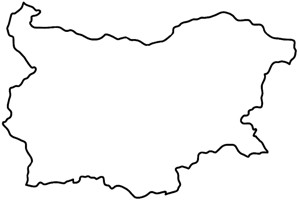
|
The Society of Folk Dance Historians (SFDH)
Šop Dances of Bulgaria
[
Home |
About |
Encyclopedia | CLICK AN IMAGE TO ENLARGE |

|
 Šopsko Horo, a name that conjures up images of flashing feet, complicated figures, and exciting dances. There is this and more, for the Šopska region is one of the richest in Bulgarian folklore. Rhythms are many and varied, steps are numerous, and it has its own unique style.
Šopsko Horo, a name that conjures up images of flashing feet, complicated figures, and exciting dances. There is this and more, for the Šopska region is one of the richest in Bulgarian folklore. Rhythms are many and varied, steps are numerous, and it has its own unique style.
First, what is and where is the Šopska region? It is a highland plateau area inhabited by a South-Slav group of people called "Šopi" and is in western Bulgaria, bounded to the east by the Sredna Gora mountains; to the north by the Stara Planina (Balkan range); to the west by Serbia, and to the south by the Rila and Osogovska Planine mountains. In addition, the Šopska region consists of six sub-divisions: Sofia, Graov, Kjustendil, Samokov, Godeč, and Ikhtiman.
What is so special about Šop dances? What makes them so exciting to watch and so much fun to do? The same things that make them so unique! Šop dances share many characteristics common to one, two, or all regions of Bulgaria of course, but they also have several distinctive features that separate them from other regions. The two most outstanding traits are style and tempo. The "natrisane," a kind of shoulder bounce, and a nimble lightness, almost a hovering over the ground, are the hallmarks of Šop style. Tempo-wise, there are some slow and moderate speed Šop dances, but most are fast. To quote a Bulgarian, "Quite a few are "whirlwind fast."
Other distinguishing features are the very intensive use of commands or calls (usually only one or two words), a greater number of complex or lengthy figures than any other region, and the exclusive and extensive use of certain movements, steps and/or movement combinations such as a kick across with only the lower part of the leg, called "kosiška;" a step and inward heel-twist called "sovalko;" a sharp kick down and back again or kind of a pump called "spasuk;" etc. Šop dances also use the largest number of complex meters, with the fast 6/8 and the fast 11/16 the most common.
Other typical traits of Šop style but also found in some of the other regions are the body being bent or leaning forward slightly, the weight being on the ball of the foot even though the step is on the whole foot, and the parts of the body such as the arms and torso not taking an independent part in the dance. Most Šop dances are mixed men and women, the most common way of holding is by belts or sashes, and formations may be in open or closed circles, semi-circles, spirals, or straight lines. The only solo dance in this region is the Šopska Rččenica. However, there also are many Šop line Rččenicas. Some examples are Kopče, Kjustendilska Lesa, and Thenska Graovska Rččenica.
With so many different movements, rhythms, and figures, there must be many dances. This author knows of 787 and has seen but not notated at least 25 more. Some of the more popular or widespread dance types are Četvorno in 7/8, Kopanica in 11/16, Petrunino in 13/16, Graovsko Horo in 2/4, and the men's Čopsko Horo in 6/8. Other well-known dances are Tsone Milo Čedo, Jovinito or Lile (mistakenly called DajČovo in the United States). They are the Kopanica-type Kiorčo (generally considered to be one of the most difficult dances); the comedy dance Zaeūkata (originally a fertility dance); and the 8/8 Dilmano Dilbero (the only Bulgarian dance in 2+3+3 or quick-slow-slow rhythm (9/8 meter). The basic Bulgarian dances also are done, such as Pajduško Horo, Eleno Mome, Pravo Horo, etc.
This is but a brief introduction to the Šop dances, an overview. Each dance type really deserves an article on itself, but basically, the preceding is what makes a Šop dance.
ACKNOWLEDGEMENTS
Professor Raine Katsarov and Stefan Vulgarov.
DOCUMENT
- Bulgaria, a country.
Used with permission of the author.
Printed in Folk Dance Scene, November 1977.
This page © 2018 by Ron Houston.
Please do not copy any part of this page without including this copyright notice.
Please do not copy small portions out of context.
Please do not copy large portions without permission from Ron Houston.